Radio Shack 12-251 User Manual

12-251.fm Page 1 Tuesday, March 14, 2000 12:40 PM
Cat. No. 12-251
OWNER’S MANUAL
Please read before using this equipment.
®
Weatheradio
with Alert
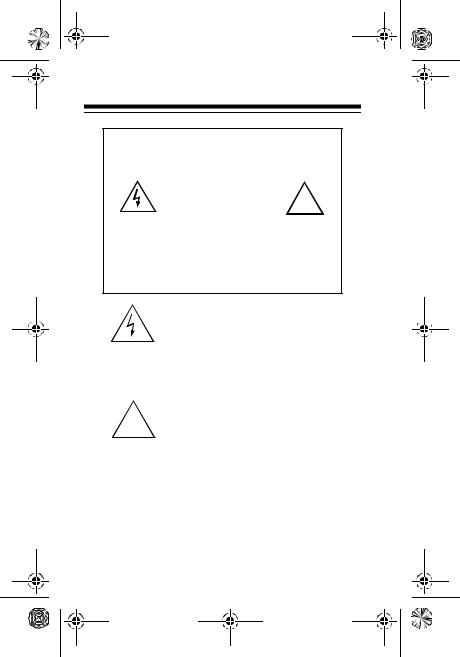
12-251.fm Page 2 Tuesday, March 14, 2000 12:40 PM
WARNING: To reduce the risk of fire or shock hazard, do not expose this product to rain or moisture.
|
CAUTION |
! |
|
RISK OF ELECTRIC SHOCK. |
|
|
DO NOT OPEN. |
|
CAUTION: TO REDUCE THE RISK OF ELECTRIC SHOCK, DO NOT REMOVE COVER OR BACK. NO USER-SERVICE- ABLE PARTS INSIDE. REFER SERVICING TO QUALIFIED PERSONNEL.
This symbol is intended to alert you to the presence of uninsulated dangerous voltage within the product’s enclosure that might be of sufficient magnitude to constitute a risk of electric shock. Do not open the product’s case.
This symbol is intended to inform you that important operating and
!maintenance instructions are included in the literature accom-
panying this product.
The graphical symbols with supplemental markings are located on the bottom of the product.
©1999 Tandy Corporation. All Rights Reserved.
RadioShack and Weatheradio are registered trademarks used by Tandy Corporation.
2
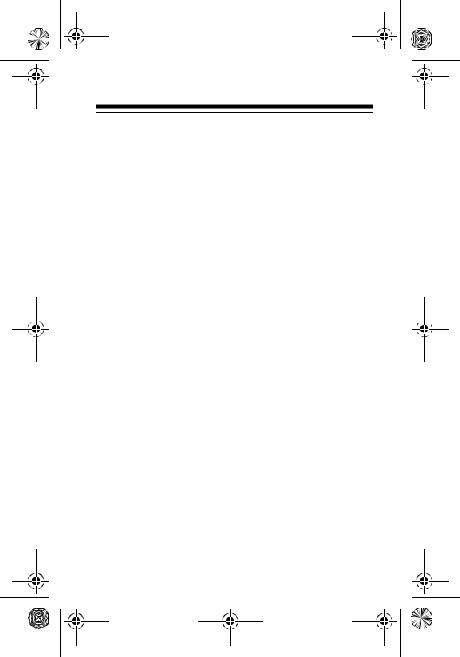
12-251.fm Page 3 Tuesday, March 14, 2000 12:40 PM
FCC DECLARATION OF
CONFORMITY
This device complies with Part 15 of the FCC Rules. Operation is subject to the following two conditions:
(1) this device may not cause harmful interference, and (2) this device must accept any interference received, including interference that may cause undesired operation.
|
|
|
|
|
Product: |
Weatheradio with Alert |
|
|
Model: |
12-251 |
|
|
Responsible Party: |
RadioShack |
|
|
|
100 Throckmorton |
|
|
|
Fort Worth, TX 76102 |
|
|
Phone: |
817-415-3200 |
|
|
|
|
|
|
|
|
|
THE FCC WANTS YOU TO KNOW
This equipment has been tested and found to comply with the limits for a Class B digital device, pursuant to Part 15 of the FCC Rules. These limits are designed to provide reasonable protection against harmful interference in a residential installation. This equipment generates, uses, and can radiate radio frequency energy and, if not installed and used in
3
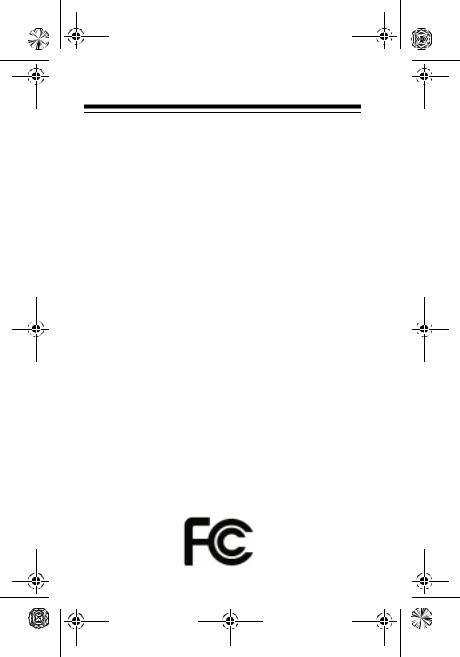
12-251.fm Page 4 Tuesday, March 14, 2000 12:40 PM
accordance with the instructions, may cause harmful interference to radio communications.
However, there is no guarantee that interference will not occur in a particular installation. If this equipment does cause harmful interference to radio or television reception, which can be determined by turning the equipment off and on, the user is encouraged to try to correct the interference by one or more of the following measures:
•Reorient or relocate the receiving antenna.
•Increase the separation between the equipment and receiver.
•Connect the equipment into an outlet on a circuit different from that to which the receiver is connected.
•Consult your local RadioShack store or an experienced radio/TV technician for help.
•If you cannot eliminate the interference, the FCC requires that you stop using your Weatheradio.
Changes or modifications not expressly approved by RadioShack may cause interference and void the user’s authority to operate the equipment.
4
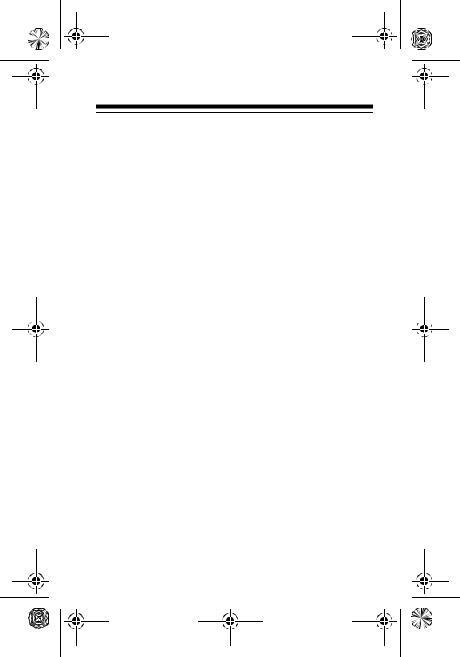
12-251.fm Page 5 Tuesday, March 14, 2000 12:40 PM
FEATURES
Your RadioShack Weatheradio with Alert is the next generation of weather alert technology. Your Weatheradio uses SAME (Specific Area Message Encoding) circuitry to provide more complete information about weather conditions in your immediate area, letting you avoid hearing alerts for geographical areas that do not interest you.
Your Weatheradio’s features include:
SAME Operation — lets you program as many as two different geographical codes into the Weatheradio’s memory, so the Weatheradio sounds an alert only when a weather emergency is declared in any of those locations.
Audible Alert — the Weatheradio sounds a built-in siren when it detects emergency weather situations.
7 Weather Channels — let you select the frequency for your local National Oceanic and Atmospheric Administration (NOAA) weather broadcasts.
Selectable Alert Function — lets you set the Weatheradio so it sounds an alert then automatically sounds the accompanying NOAA broadcast when it receives a weather emergency broadcast. You can also set the Weatheradio so it sounds only the alert, letting you manually tune the NOAA broad-
cast.
5
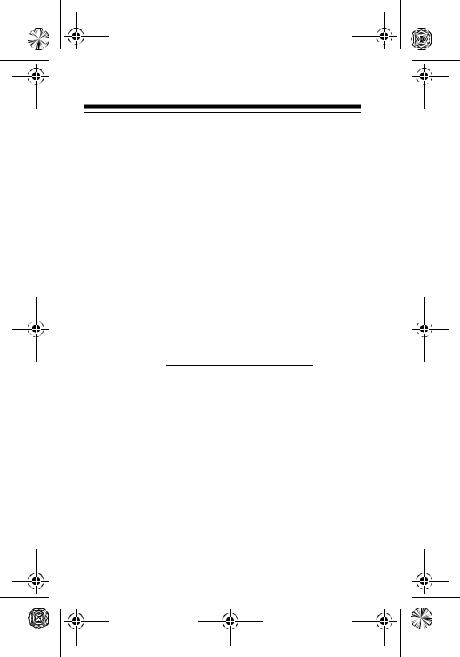
12-251.fm Page 6 Tuesday, March 14, 2000 12:40 PM
Alert Indicator Lights — the Weatheradio’s display clearly shows whether a received alert is a state-  ment, watch, warning, or emergency.
ment, watch, warning, or emergency.
Battery Backup — the Weatheradio uses a 9-volt battery (not supplied) for backup power if AC power fails or is temporarily disconnected.
Alert Volume Control — lets you adjust the volume of the siren so you will be sure to hear it.
We recommend you record your Weatheradio’s serial number here. The number is on the bottom of the radio.
Serial Number:
6

12-251.fm Page 7 Tuesday, March 14, 2000 12:40 PM
CONTENTS |
|
How Your Radio Works ....................................... |
8 |
When a Weather Alert Occurs ....................... |
9 |
Understanding FIPS Codes ........................... |
9 |
Obtaining Your Area’s FIPS Code(s) .... |
11 |
Preparation ........................................................ |
12 |
Powering the Weatheradio ........................... |
12 |
Connecting AC Power .......................... |
12 |
Installing the Backup Battery ................ |
13 |
Using the Built-In Antenna ........................... |
14 |
Choosing a Location for the Weatheradio ... |
15 |
Programming the Weatheradio .................... |
16 |
Selecting a Broadcast Frequency ........ |
17 |
Storing/Changing FIPS Codes ............. |
19 |
Testing the Weatheradio .............................. |
21 |
Operation ........................................................... |
22 |
Listening to a Weather Broadcast ............... |
22 |
Using the Alert Function .............................. |
23 |
Setting the Alert Volume ....................... |
24 |
Changing/Checking the Alert Pattern ... |
24 |
Using the Weatheradio’s |
|
‘All Signals’ Code ................................. |
25 |
When a Test or Demo Alert Occurs ...... |
26 |
Troubleshooting ................................................ |
28 |
Care .................................................................... |
31 |
Specifications ................................................... |
32 |
|
7 |

12-251.fm Page 8 Tuesday, March 14, 2000 12:40 PM
HOW YOUR RADIO WORKS
Traditional weather radios simply receive NOAA’s weather broadcast (usually within a 50-mile radius) then sound an alarm if any emergency code was transmitted along with the broadcast. This means that people who live outside an affected area are often alerted even when their area is not affected, causing many of them to ignore potentially real weather warnings that can save lives.
In 1994, the National Oceanic and Atmospheric Administration (NOAA) began broadcasting coded signals called FIPS (Federal Information Processing System) codes along with their standard weather broadcasts from stations in your area. These codes identify the type of emergency and the specific geographic area (such as a county) affected by the emergency. Your Weatheradio receives, interprets, and displays information about the codes so you can determine if the emergency might affect your area. Only SAME-compatible weather radios (such as this Weatheradio) are able to take advantage of this new technology.
Each FIPS code identifies a specific geographic area (defined by the National Weather Service), so your Weatheradio sounds an alert only when a weather emergency is declared in that area. This helps you more efficiently track the weather conditions in and around your area.
8

12-251.fm Page 9 Tuesday, March 14, 2000 12:40 PM
WHEN A WEATHER ALERT OCCURS
When the Weatheradio receives a weather alert:
•it sounds the built-in siren
•an indicator on the front of the Weatheradio lights
Warning: The NWS uses sophisticated weather models to determine an alert’s effective time. However, the end of an alert does not necessarily mean that the related weather emergency is over.
UNDERSTANDING FIPS CODES
For the purpose of broadcasting weather information, the NWS has divided the United States into regions by state and county (or parish, where applicable) then assigned a 6-digit FIPS code to identify each county or parish. For example, the code for Tarrant County, Texas, is 048439.
9

12-251.fm Page 10 Tuesday, March 14, 2000 12:40 PM
The first digit in a FIPS code identifies the county subdivision, the next two digits identify the state, and the last three digits identify the county or parish.
State
048439
County/
Parish
County Subdivision
Note: Most FIPS codes begin with 0, which means the code represents an entire county. The NWS, however, plans to eventually subdivide some large counties. When that happens, each subdivision will be assigned a digit from 1–9, resulting in codes such as 148439, 248439, and so on.
Your Weatheradio can receive all SAME alert signals broadcast within about a 50-mile radius of where you installed it. To receive SAME alerts and broadcasts about weather occurring only in particular counties within that area, you can program up to two FIPS codes into the Weatheradio’s memory. For example, this lets you avoid hearing an alert that applies to an area within a 50-mile radius but not necessarily to your county or parish.
10

12-251.fm Page 11 Tuesday, March 14, 2000 12:40 PM
Obtaining Your Area’s FIPS Code(s)
To obtain the FIPS code for the location where you installed your Weatheradio, contact your local RadioShack store or call the NWS toll free at 1-888- NWR-SAME (1-888-697-7263). If you call the NWS, follow the instructions you hear.
Note: If you are close to a county or parish line, you might want to obtain the codes for the nearby counties or parishes.
Hint: Since you can program up to two FIPS codes into the Weatheradio’s memory, you might want to obtain the code for another local area that you frequently travel through (as long as both areas are within a 50 mile radius of your location and within an area covered by your local NWS broadcast station). That way, you can program the code into the Weatheradio and receive broadcasts covering that location, too.
11
